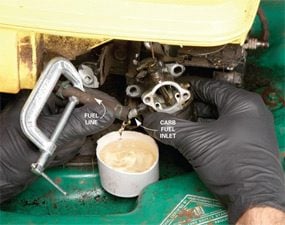How to Repair Small Engines: Cleaning the Lawn Mower Carburetor
Updated: Apr. 18, 2023
Don't Google "small engine repair near me" the next time your lawnmower sputters. Learn how to do it yourself. Small engine repair is all about a clean carburetor.
A full day
Intermediate
$51–100
Introduction
Solve most lawnmower or other small engine starting problems with a simple diagnosis and a carburetor cleaning or rebuilding. It will only take a few hours, and you'll avoid the minimum $80-plus-parts repair bill.Tools Required
- 4-in-1 screwdriver
- Adjustable wrench
- Clamps
- Needle-nose pliers
- Nut driver
- Organic vapor respirator
- Socket/ratchet set
Materials Required
- Carburetor cleaner
- Carburetor rebuild kit
- Plastic gloves
- Stiff wire
If you can’t get a small engine started, it takes too many pulls to get it going, or it runs poorly, ask yourself this: Did it sit for a long time with gas in it? Like over the winter? If so, your problem is most likely a corroded or gummed-up carburetor. Small engine repair shops earn about 50 percent of their revenue by cleaning or replacing carburetors sidelined by old gas. Look at your lawnmower carburetor next time you sharpen the blades or complete a lawn mower tune-up.
Before you start taking things apart, take a minute to confirm the carburetor is the problem. We’ll show you how to do that, as well as how to clean, rebuild or replace a lawnmower carburetor. Either way, you’ll save about an hour of shop labor (about $80). You can complete the carburetor rebuild project in a single morning, including the time scouting for parts.
How to Find Lawn Mower Carburetor Parts and Prices
Whether you buy parts from a local small engine repair shop or online, you may need all this information:
- Machine brand (Toro, Snapper, Honda, etc.), model and serial number.
- Engine brand and serial number (Tecumseh, Briggs & Stratton, Honda, etc.). The engine model and serial number are usually located on a plate above the spark plug.
- You may also need numbers from the old carburetor itself, usually stamped onto the carb body or its mounting flange.
- You can buy locally, or try smallenginepartswarehouse.com or psep.biz.
Where is the Carburetor on a Lawn Mower?
The carburetor is usually located towards the top of the engine, and is connected to the gas tank.
Project step-by-step (8)
Start Your Engine (At Least Try)
- Confirm that the fuel valve is on, there’s gas in the tank and the spark plug is in good shape.
- Shoot a one-second burst of aerosol lubricant or carburetor cleaner down the throat of the carburetor.
- Then, yank the cord.
- Note: If the engine runs (even just sputters) and dies, you have a fuel problem. If there’s no life after a few tries, it’s something more serious and you need to haul the engine to your garage for some detective work.
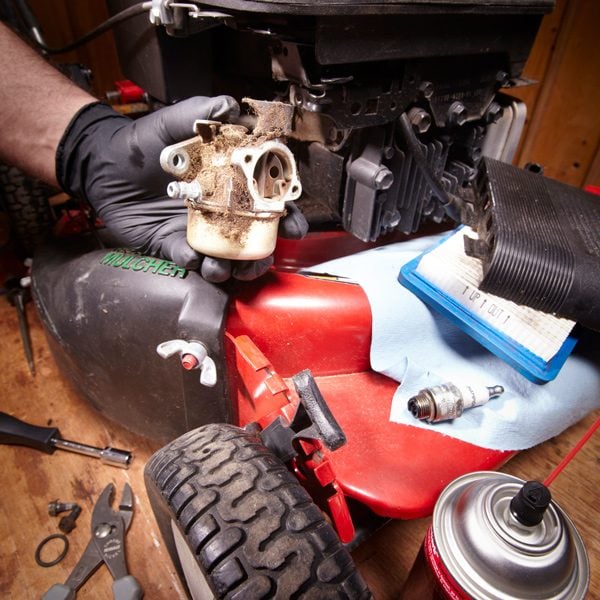
Test for Gas at the Lawn Mower Carburetor
- Clamp off the fuel line.
- Compress the spring clamp and slide it backward on the fuel line.
- Pull the tubing off the carburetor nipple and catch the gas in a small bowl.
- Note: If no gas comes out of the fuel line, you’ve got a plugged fuel line or fuel filter.
Remove the Lawn Mower Carburetor
- Use a socket or nut driver to remove the two bolts that hold the carburetor to the engine.
- Unhook the throttle cable from the carburetor linkage.
- Place the carburetor in a container (to catch the gas).
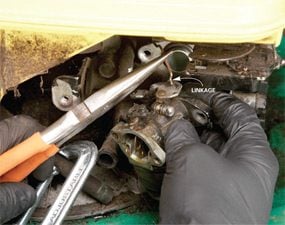
Check for Corrosion
- Open the carburetor bowl to check for corrosion.
- Note: If the inside of the carburetor is corroded, it needs to be replaced. Even after cleaning, the corrosion will clog the jets and tiny orifices and restrict the flow of gas.

Rebuild or Replace?
If there’s no corrosion in the carburetor, you can choose to rebuild it rather than replace it. But rebuilding isn’t always cheaper, and it might not even do the trick. Sometimes you can buy a new carburetor for less than (or pretty darn close to) the cost of the rebuilding kit plus the cost of the chemicals. We always just replace bad carburetors rather than rebuild them.
If you opt to rebuild, follow the steps below:
Dissect the Lawn Mower Carburetor on Your Workbench
- Start the disassembly from the bottom (bowl, float, needle, seat, etc.) and keep all the parts together.
- Pro tip: Shoot digital photos for help during reassembly.
- Match the new gaskets and O-rings in the carburetor repair kit to the old ones.
- Set aside the used gaskets and O-rings you’ll discard, and any parts from the kit you don’t need.
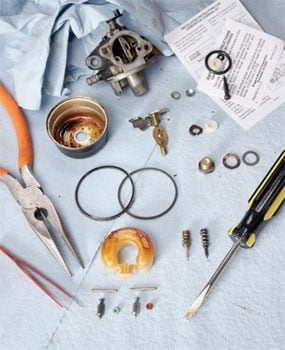
Clean the Parts
- Wire all the larger parts together and drop them into a bucket of carburetor cleaner.
- Then, wrap the small parts in a piece of aluminum screen or use a fine-mesh basket, and drop them in the bucket as well.
- Note: New/replacement parts don’t need to be cleaned.
- Let the parts soak for one hour.
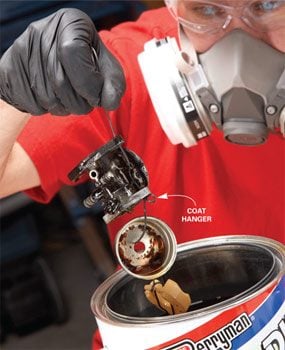
Reassemble the Lawn Mower Carburetor
- After the hour is up, rinse all the parts with water and blow them dry with compressed air.
- Reassemble the old and new carburetor parts and then mount it on the engine.
- Follow the instructions in the kit for adjusting the idle speed and mixture.
- Finally, fire up your engine and listen to it purr!
- Congratulations, you’ve fixed your carburetor without having to google “small engine repair near me.”

